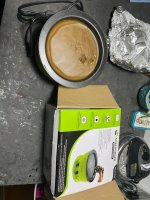Ventura
Been here for ages!
well, let's not have unrealistic expectations added to the legend of reedwork
the system of waxless reed mounting is not an alternative they flip
a coin in some accordion factory and do it one way today and another
tomorrow.. affixing reeds by using leather gasket type material and
nails or screws carefully placed is an ART and requires quite a bit
of SKILL as well as the TOOLING at a higher level to prepare the
reedblock for such perfect mating of the surfaces.
normal reedblocks are planed pretty nicely, fairly flat, but to
the level needed for waxless mounting ? is the wood of a thickness
and type that will hold these nails to this level of perfection of
hold strength ? (as opposed to nails just holding the reeds more
or less spaced and in place so that lower level workers can pour
the wax into place, which is really what is relied upon for less
than perfect surfaces to seal perfectly..
if you are working on an accordion that has waxed in reeds,
playing games might be fun and even work for a minute, but
if they used wax originally and it needs re-done, then just re-wax it
or at least re-melt the wax that is there before you start playing
fun and games with those little bitty nails
frankly, i would just take them out on a waxed box.. i certainly
do not have the patience to make sure they are all still seated firmly, and
i can easily imaging that if even one little nail came loose
next week
next month
even ONE
it could be / gonna end up coming through your bellows somewhere
in a bad place and THEN whattya gonna do about it ?
fugghedabout those damn spikey nails, they are of little importance
50 years 80 years later on a WAXED reedblock and most certainly should
not be expected to hold reeds in an airtight buzz free manner as a
primary function
how many of you even have the dedicated/proper tool for setting brads ?
(partial rant ends now)
the system of waxless reed mounting is not an alternative they flip
a coin in some accordion factory and do it one way today and another
tomorrow.. affixing reeds by using leather gasket type material and
nails or screws carefully placed is an ART and requires quite a bit
of SKILL as well as the TOOLING at a higher level to prepare the
reedblock for such perfect mating of the surfaces.
normal reedblocks are planed pretty nicely, fairly flat, but to
the level needed for waxless mounting ? is the wood of a thickness
and type that will hold these nails to this level of perfection of
hold strength ? (as opposed to nails just holding the reeds more
or less spaced and in place so that lower level workers can pour
the wax into place, which is really what is relied upon for less
than perfect surfaces to seal perfectly..
if you are working on an accordion that has waxed in reeds,
playing games might be fun and even work for a minute, but
if they used wax originally and it needs re-done, then just re-wax it
or at least re-melt the wax that is there before you start playing
fun and games with those little bitty nails
frankly, i would just take them out on a waxed box.. i certainly
do not have the patience to make sure they are all still seated firmly, and
i can easily imaging that if even one little nail came loose
next week
next month
even ONE
it could be / gonna end up coming through your bellows somewhere
in a bad place and THEN whattya gonna do about it ?
fugghedabout those damn spikey nails, they are of little importance
50 years 80 years later on a WAXED reedblock and most certainly should
not be expected to hold reeds in an airtight buzz free manner as a
primary function
how many of you even have the dedicated/proper tool for setting brads ?
(partial rant ends now)










